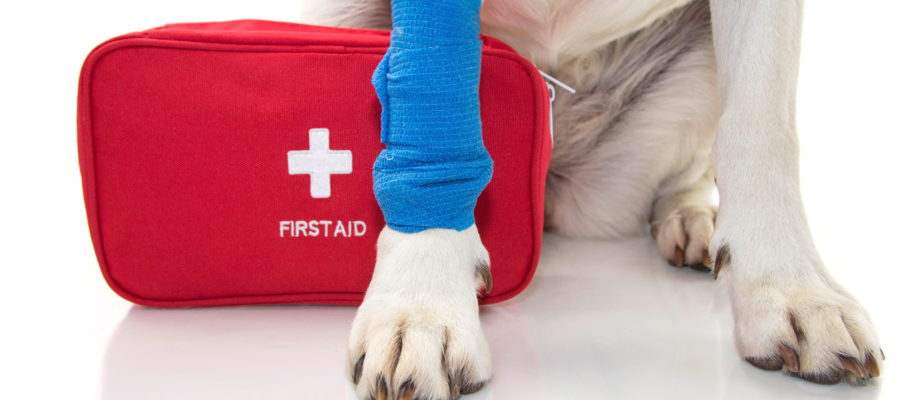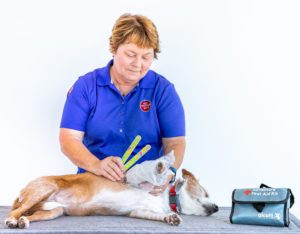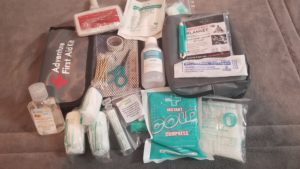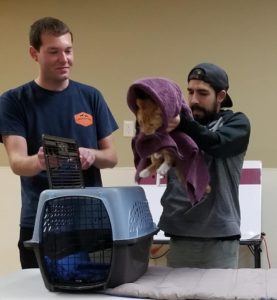Unleash Your Inner Mutt-gyver
Tips, Tricks and Tactics to Render Aid to Injured Pets

 By Arden Moore – The Pet Health and Safety Coach™
By Arden Moore – The Pet Health and Safety Coach™
April is National Pet First Aid Awareness month and a good opportunity for us all to become more aware of how to prevent accidents and injuries as well as learn some tips to help us remain calm and able to help our pets when a problem arises at home or away.
As a master certified pet first aid/CPR instructor and founder of Pet First Aid 4U and director of the pet first aid instructor training program for Pro Pet Hero, I teach hands-on, veterinarian approved classes in person and via ZOOM with the assistance of my terrier mix, Kona and my orange tabby, Casey.
 One of the first things I encourage all pet parents to have is a first aid kit. The ASPCA offers a list of helpful items to have on hand. When a pet first aid kit is available with some basics, you can reach with confidence for the splints and triangular bandages to immobilize your dog’s sprained front leg, remove a tick or parasite on your cat’s back, or clean up a wound with an antiseptic wipe.
One of the first things I encourage all pet parents to have is a first aid kit. The ASPCA offers a list of helpful items to have on hand. When a pet first aid kit is available with some basics, you can reach with confidence for the splints and triangular bandages to immobilize your dog’s sprained front leg, remove a tick or parasite on your cat’s back, or clean up a wound with an antiseptic wipe.
What can you do when a first aid kit isn’t nearby? The reality is that a fully stocked pet first aid kit is not always available when a pet gets injured. Or the kit may be missing some must-have items you forgot to replace. Plus, who totes a pet first aid kit on a neighborhood walk or a trip to the dog park or a pet event? No pet first aid kit? No problem! Keep reading for some surprising items you can use.
UNLEASH YOUR INNER “MUTT-GYVER”
 Just like the hero in the 1980s original MacGyver television show (and the new one now airing on CBS), the goal of being a Mutt-gyver for pets centers on using everyday items in creative but effective ways as pet first aid tools. Here are some of my “think-outside-the-box” ideas to care for your pet in the event you need to stabilize and safely transport your injured pet to the vet clinic, provide aid if your pet is stung by a wasp or jellyfish, or how you can your pet when overheated.
Just like the hero in the 1980s original MacGyver television show (and the new one now airing on CBS), the goal of being a Mutt-gyver for pets centers on using everyday items in creative but effective ways as pet first aid tools. Here are some of my “think-outside-the-box” ideas to care for your pet in the event you need to stabilize and safely transport your injured pet to the vet clinic, provide aid if your pet is stung by a wasp or jellyfish, or how you can your pet when overheated.
- Unused doggie plastic poop bags: These “deposit-collectors” offer a multitude of uses. Rolled lengthwise it can be used as a temporary muzzle on an injured small dog because stressed dogs may bite. It can also be shaped into a bowl to create a makeshift water bowl on a walk. These bags have other helpful uses such as a tie to secure a leg split. A bag can also be used to hold in place a bloody paw wrapped in a spare sock with a second doggy bag used as a tie to secure the wrapping.
- H20 to the rescue: Dogs and cats do not sweat as we do. They lack the skin pores people have. Rather they pant and perspire through their paws. Hydration and lowering their body temperature is the key to helping a dog who is overheated. Cooldown your dog by getting him to shade and create a bowl from a doggy bag or a baseball hat for your dog to drink water from as well as to dip their paws.
- Bottled water, popsicle sticks, and bubble wrap: An unopened water bottle can act as a temporary splint on a leg sprain or break of a large dog. For cats and smaller dogs, you can use paint stir sticks, popsicle sticks, or emery boards. It is important to first cushion the injured limb with bubble wrap or a rolled-up magazine. Then position two makeshift splints and wrap the limb with a pair of shoelaces, a bandana, or a roll of gauze.
- Shoelaces, socks, and hair ties: These three items have amazing uses. A sock can serve as a makeshift wound wrap for a bloody or cut paw. Shoelaces can double as temporary restraint muzzles on small dogs and hold a splint or wound wrap in place on a paw. Those elastic bands often used as hair ties to secure a person’s hair can come in handy in a pinch as a way to also secure a split or wound wrap.
- Credit card, driver’s license, and seashells: The rigidness of these items makes excellent tools if you spot a stinger of a wasp or bee in your pet’s skin. Do not try removing it using tweezers or your fingernails; you risk rupturing the venom sac and spreading the toxins in the pet’s body. Instead, take the edge of a credit card or driver’s license and scrape it like a spatula to lift out the stinger. After the stinger has been removed, a dab of moistened baking soda on a minor sting can take out the ouchy.
 The credit card and driver’s license can also be used if your dog gets stung by a jellyfish while at the beach. A medium-sized seashell, cupped in your hand can also work to scrape off the jellyfish tentacles from the dog. Be sure to follow up by rinsing the jellyfish sting site using saltwater and never fresh water.
The credit card and driver’s license can also be used if your dog gets stung by a jellyfish while at the beach. A medium-sized seashell, cupped in your hand can also work to scrape off the jellyfish tentacles from the dog. Be sure to follow up by rinsing the jellyfish sting site using saltwater and never fresh water.
- Aloe plant: Aloe vera can be your pet first aid “pal-o” on hikes or in the house if you have this plant. The gel from the leaves can be applied to ease minor burns and insect stings.
- Ikea blue shopping bags: These inexpensive blue plastic shopping bags make great gurneys to transport large dogs. Simply cut off the front and back ends of the bag. The plastic-lined bag does not rip and easily glides on all surfaces, especially carpet and rugs. This is far better than large bath towels that tend to drag on carpeted surfaces due to friction.
- Bath towels and laundry baskets: If you need to take an injured, agitated cat to the veterinarian, wrap him in a thick bath towel and place him in the top side of a pet carrier (far easier than trying to coax him into the front door of the carrier). If you don’t have a pet carrier handy, place an empty laundry basket over the cat, slide a thin board or thick cardboard underneath then gently turn over the laundry basket and you have created a Mutt-gyver cat carrier.
For a quick video of some of what was shared in this blog, click here.
BE YOUR PET’S HEALTH ALLY
April is Pet First Aid Awareness month and learning pet first aid is a skill all of us pet lovers need to be ready to use any time, any where. Having these skills could save their life and that is priceless. Developing first aid skills can also promote your confidence to handle an emergency and help to reduce the stress of your pet. The main tip is to remain calm during a pet emergency. Focus on the present moment and pay attention to your surroundings. Enrolling in a pet first aid/CPR class is one of the best ways to truly be a health ally for your pets and those under your care. Kona, Casey, and I hope to see you in one of our upcoming classes!
 Arden Moore wears many collars in the pet world. She is a best-selling author, master certified pet first aid/CPR instructor, pet behavior consultant, host of the Oh Behave Show on Pet Life Radio and happy pet parent to a Furry Brady Bunch in Dallas. Learn more at www.ardenmoore.com.
Arden Moore wears many collars in the pet world. She is a best-selling author, master certified pet first aid/CPR instructor, pet behavior consultant, host of the Oh Behave Show on Pet Life Radio and happy pet parent to a Furry Brady Bunch in Dallas. Learn more at www.ardenmoore.com.

